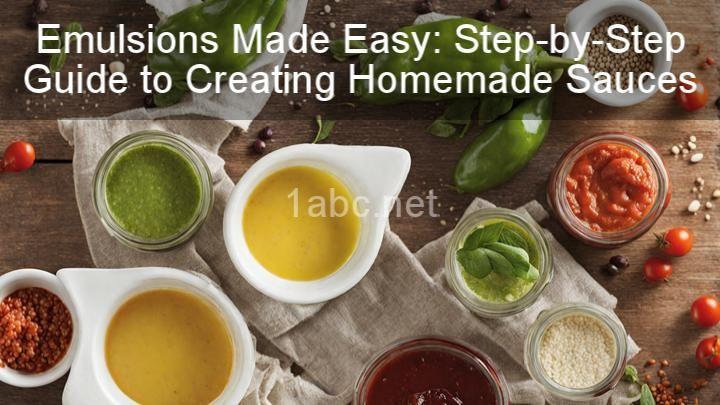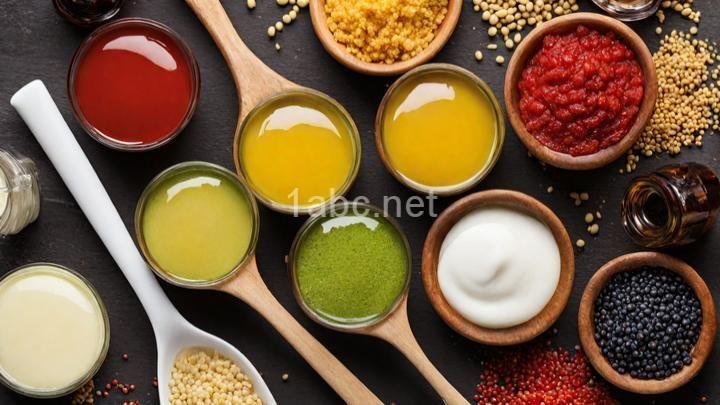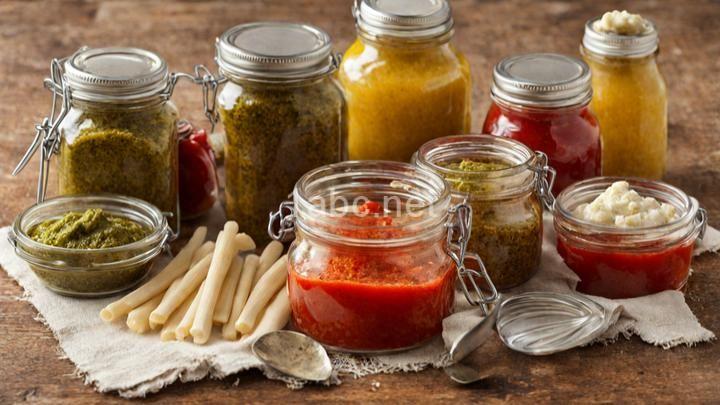Emulsions Made Easy: Step-by-Step Guide to Creating Homemade Sauces
I. Understanding Emulsions
II. Essential Ingredients and Tools
III. Step-by-Step Instructions
Step 1: Choose your oil or fat
Step 2: Select your acid
Step 3: Incorporate water-based ingredients
Step 4: Prepare your egg yolks
Step 5: Begin the emulsion process
Step 6: Adjust consistency and flavor
Step 7: Storing and serving

Introduction
Welcome readers to a friendly, step-by-step guide on creating homemade sauces through the process of emulsification. Making sauces from scratch can seem daunting, but with a little understanding of emulsions and the right ingredients and tools, you can easily master the art of homemade sauces. In this guide, we will explore the science behind emulsions, the essential ingredients and tools needed, and provide detailed step-by-step instructions to help you create delicious emulsified sauces at home.
I. Understanding Emulsions
To begin, let's define what an emulsion is. An emulsion is a mixture of two or more liquids that are normally immiscible, meaning they do not naturally mix together. In the context of sauces, emulsions occur when oil or fat is dispersed evenly throughout a watery liquid, creating a smooth and stable sauce. Some common examples of emulsified sauces include mayonnaise, hollandaise, and vinaigrettes.
The science behind emulsions lies in the interaction between the oil or fat molecules and the water molecules. Oil and fat molecules are hydrophobic, meaning they repel water, while water molecules are hydrophilic, meaning they are attracted to water. To create an emulsion, an emulsifier is needed to bridge the gap between these two types of molecules. Emulsifiers, such as egg yolks, contain both hydrophobic and hydrophilic properties, allowing them to stabilize the mixture and prevent separation.
II. Essential Ingredients and Tools
Before diving into the step-by-step instructions, it's important to gather the essential ingredients and tools needed to create emulsified sauces. The basic ingredients for emulsified sauces include oil or fat, acid, water, and egg yolks.
When selecting your oil or fat, choose one that has a neutral flavor, such as vegetable oil or light olive oil, or opt for a more robust flavor like extra virgin olive oil or avocado oil. The choice of oil or fat will greatly impact the taste of your sauce, so it's important to select one that complements the other flavors in your recipe.
Next, consider the acid component of your sauce. Common options include vinegar, lemon juice, lime juice, or any other citrus fruit juice. The acid not only adds flavor but also helps to balance the richness of the oil or fat.
Incorporating water-based ingredients is another crucial step in creating emulsified sauces. This can include adding water itself, or water-based flavorings such as herbs, spices, or liquids like mustard or Worcestershire sauce. These ingredients enhance the overall flavor profile of your sauce.
Finally, egg yolks act as natural emulsifiers in many sauces. They help to stabilize the mixture and prevent separation. Make sure to select fresh eggs and separate the yolks from the whites, as the whites can interfere with the emulsification process.
In addition to the essential ingredients, you will need some tools to assist in the emulsification process. A whisk is a basic tool that can be used for smaller batches, while a blender or food processor can be helpful for larger quantities. Choose the tool that best suits your needs and the size of your batch.
III. Step-by-Step Instructions
Now that you have gathered your ingredients and tools, let's dive into the step-by-step instructions for creating homemade emulsified sauces.
1.
Step 1: Choose your oil or fat
Start by selecting the oil or fat that will be the base of your sauce. Consider the flavor profile you want to achieve and choose an oil or fat that complements your other ingredients. If you're unsure, start with a neutral oil like vegetable oil or light olive oil.
When choosing oils or fats, it's important to select high-quality options. Look for cold-pressed oils or fats that are minimally processed. These oils will have a better flavor and higher nutritional value.
2.
Step 2: Select your acid
Once you have chosen your oil or fat, it's time to select your acid. This component adds brightness and tang to your sauce. Common options include vinegar, lemon juice, lime juice, or even a combination of these. Consider the flavor profile you want to achieve and experiment with different acids to find the perfect balance.
3.
Step 3: Incorporate water-based ingredients
Next, it's time to incorporate water-based ingredients into your sauce. This can include adding water itself or using water-based flavorings such as herbs, spices, or liquids like mustard or Worcestershire sauce. These ingredients add depth and complexity to your sauce, so feel free to experiment with different combinations to create unique flavors.
When adding water-based ingredients, it's important to balance the flavors. Start with a small amount and gradually add more, tasting as you go. This will help you achieve the desired consistency and flavor.
4.
Step 4: Prepare your egg yolks
Egg yolks act as natural emulsifiers in many sauces. They help to stabilize the mixture and create a smooth, creamy texture. To prepare your egg yolks, crack the eggs and separate the yolks from the whites. It's important to use fresh eggs for the best results.
5.
Step 5: Begin the emulsion process
Now it's time to begin the emulsion process. Start by whisking or blending your egg yolks until they become smooth and creamy. Gradually add the oil or fat in a slow, steady stream while continuously whisking or blending. This gradual addition of oil allows the emulsion to form and prevents the mixture from separating.
If at any point the mixture starts to separate, stop adding oil and whisk vigorously to bring it back together. If the separation persists, start over with a fresh batch of egg yolks and slowly incorporate the separated mixture into the new batch.
6.
Step 6: Adjust consistency and flavor
Once you have achieved a smooth and creamy emulsion, it's time to adjust the consistency and flavor of your sauce. If your sauce is too thick, you can thin it out by adding a small amount of liquid, such as water or additional acid. Conversely, if your sauce is too thin, you can thicken it by whisking in more oil or fat.
Taste your sauce and adjust the flavor by adding more acid, salt, or any other seasonings according to your personal preference. Remember that the flavors will develop and intensify over time, so it's better to start with a slightly milder flavor and adjust as needed.
7.
Step 7: Storing and serving
Congratulations, you have successfully created a homemade emulsified sauce! To store your sauce, transfer it to a clean, airtight container and refrigerate it. Homemade sauces can typically be stored for about a week, but always check for any signs of spoilage before using.
There are endless ways to enjoy your homemade sauce. Use it as a dip for vegetables or seafood, as a dressing for salads, or as a spread for sandwiches or burgers. Get creative and experiment with different dishes and flavor combinations.
Conclusion
In conclusion, creating homemade emulsified sauces is a rewarding and delicious endeavor. By understanding the science behind emulsions and following the step-by-step instructions provided in this guide, you can confidently create a wide variety of sauces from scratch. Remember to select high-quality ingredients, experiment with different flavors, and adjust the consistency and flavor to your personal preference. Thank you for joining this friendly, step-by-step guide to mastering homemade sauces through emulsion. Happy sauce-making!
FREQUENTLY ASKED QUESTIONS
What is Emulsions Made Easy?
Emulsions Made Easy is a detailed guide or tutorial on the process of making emulsions. An emulsion is a mixture of two or more immiscible substances, such as oil and water, stabilized by a third substance called an emulsifier. This guide provides step-by-step instructions, tips, and techniques to help you successfully create emulsions in your own kitchen or laboratory. It covers various types of emulsions, common emulsifiers, and troubleshooting tips for achieving desired results. Whether you are interested in culinary applications or industrial formulations, Emulsions Made Easy is a valuable resource for understanding and mastering the art of emulsification.
How can this guide help me create homemade sauces?
This guide can help you create homemade sauces by providing you with step-by-step instructions, recipes, and tips on how to make a variety of sauces from scratch. It will also give you a better understanding of the basic techniques and ingredients used in sauce-making, empowering you to experiment and create your own unique sauces. Whether you're looking to make pasta sauces, barbecue sauces, or salad dressings, this guide can be a valuable resource to enhance your culinary skills and create delicious homemade sauces.
What kind of homemade sauces can I create using this guide?
With this guide, you can create a variety of homemade sauces. Some popular options include:
- Tomato Sauce: Made with tomatoes, onions, garlic, and various herbs and spices.
- Marinara Sauce: Similar to tomato sauce, but usually includes basil, oregano, and sometimes red wine.
- Alfredo Sauce: A rich and creamy sauce made with butter, cream, and grated Parmesan cheese.
- Pesto Sauce: A sauce made with fresh basil leaves, pine nuts, garlic, Parmesan cheese, and olive oil.
- BBQ Sauce: A tangy and sweet sauce made with ketchup, vinegar, brown sugar, and spices like paprika and garlic powder.
- Teriyaki Sauce: A thick and savory sauce made with soy sauce, brown sugar, garlic, ginger, and sometimes pineapple juice.
- Hollandaise Sauce: A creamy and buttery sauce made with egg yolks, butter, lemon juice, and a pinch of cayenne pepper.
- Chimichurri Sauce: A zesty and herby sauce made with parsley, cilantro, garlic, red pepper flakes, vinegar, and olive oil.
- Salsa Verde: A tangy and fresh sauce made with tomatillos, jalapenos, garlic, onions, cilantro, and lime juice.
- Peanut Sauce: A flavorful sauce made with peanut butter, soy sauce, ginger, garlic, lime juice, and sometimes chili sauce.
Feel free to explore these homemade sauce recipes and customize them to suit your taste preferences.
Do I need any special equipment or ingredients?
It depends on what you are referring to. Could you please specify which activity or recipe you are asking about?



